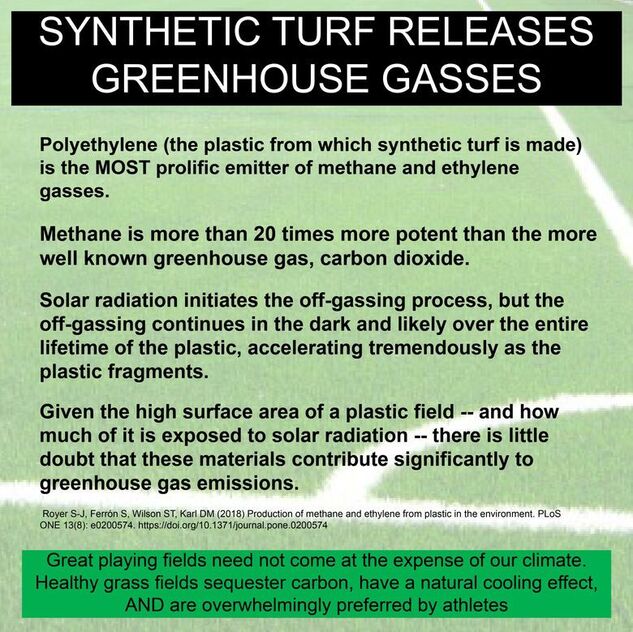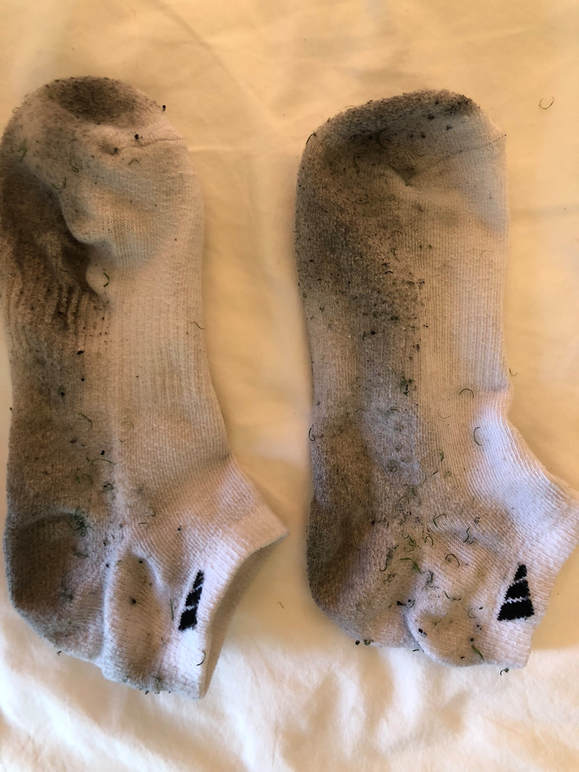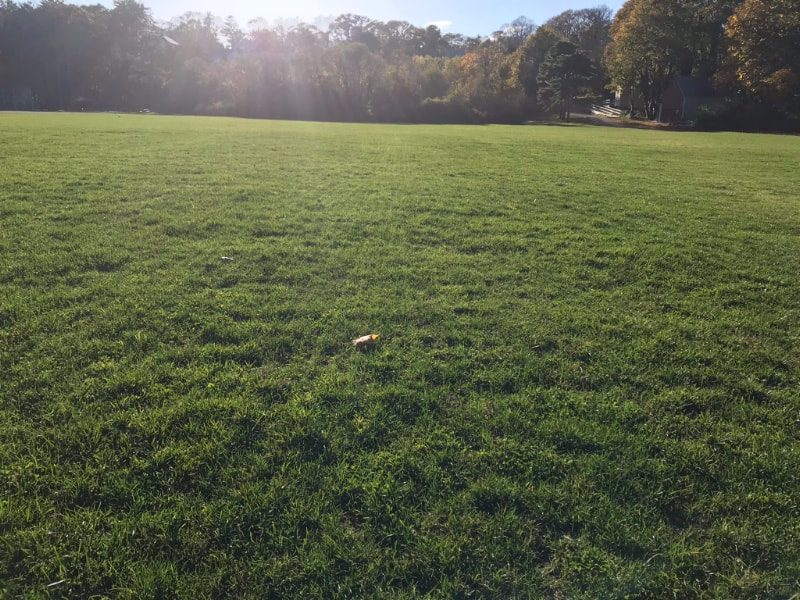What do we know about synthetic turf fields?
- There are between 12,000 and 13,000 synthetic turf sports fields in the United States currently, with more than a thousand new installations each year.
- A 2020 Synthetic Turf Council report estimates, "that the total installed value of synthetic turf in North America is $2.7 billion, with industry growth of 15 percent since 2017. This activity translates into approximately 265 million square feet (24.6 million square meters) of installed turf and 777 million pounds (352 million kilos) of infill."
- About 750 fields are removed (and replaced) in the U.S. annually.
Many municipal and school district officials are being told that for the price, artificial fields will give us better playability, and that they pose no additional health or environmental risks. But are they getting the real story?
Let’s look at the cost.
To sell synthetic turf fields, the industry greatly over-estimates the number of hours they can be used in a year, and greatly underestimates the amount of hours an organically maintained grass field can be used. They then compare costs based on this wildly inaccurate estimate of use. Case in point, one city’s paid consultants and designers of a new proposed synthetic field, said a natural grass field could only be used 100 hours a year. One of the nation’s leading organic grass experts, has provided case studies from both Marblehead and Springfield, Massachusetts, showing organically maintained grass fields being used over 1,000 hours a year – more than 10 times as much as the synthetic turf industry says – making natural grass that much more cost effective.
Some groups are thinking that a synthetic surface will solve all their maintenance problems. It still amazes me when I hear the amount of money a school is willing to spend on a synthetic field when they were reluctant to spend a small fraction of that cost on either the proper construction or maintenance of their natural grass field.
- Grady Miller, Ph.D., Professor and Extension Turf Specialist, North Carolina State University - SportsField Management, May 7, 2021
Detailed life cycle cost studies clearly show organically maintained natural grass playing fields are by far the most cost effective and sustainable solution.
Synthetic turf is a fossil fuel intensive product.
From the beginning to the end of its lifecycle, synthetic turf contributes to climate change. From the petroleum used to produce it, to the heat island effect it creates, to the greenhouse gases it emits when it breaks down - these plastic fields are the opposite of sustainable.
Synthetic turf contains toxic chemicals.
The plastic carpet itself is treated with toxic chemicals like flame retardants. The infills used are also hazardous. The Environmental Protection Agency states that, “existing studies do not comprehensively evaluate the concerns about health risks from exposure to tire crumb.”
Tire crumb or crumb rubber, the most common infill, contains at least 92 chemicals, 11 of which are known carcinogens, and heavy metals like lead, sometimes at high levels. The CDC has concluded that there is no reliable evidence for a safe level of lead. Lead has been found in numerous samples of synthetic turf fields—even after the industry promised to stop using lead to dye the plastic grass. Lead is known to reduce IQ points in children.
The backing and plastic carpet have also been found to contain PFAS, a highly persistent class of chemicals linked to cancer, birth defects, and other illnesses.
Tire crumb or crumb rubber, the most common infill, contains at least 92 chemicals, 11 of which are known carcinogens, and heavy metals like lead, sometimes at high levels. The CDC has concluded that there is no reliable evidence for a safe level of lead. Lead has been found in numerous samples of synthetic turf fields—even after the industry promised to stop using lead to dye the plastic grass. Lead is known to reduce IQ points in children.
The backing and plastic carpet have also been found to contain PFAS, a highly persistent class of chemicals linked to cancer, birth defects, and other illnesses.
Synthetic turf pollutes.
Synthetic turf must be replaced every 8-10 years on average, sometimes much less. About 750 fields are removed in the U.S. annually. The most likely end of life scenario for a synthetic turf field is being brought to a landfill. Even if they are repurposed, this simply delays the inevitable.
Despite industry promises, recycling is very complicated, and not cost effective. While it can technically be recycled, this is not happening in the United States as there is yet a facility here that does it. This, like repurposing is still simply kicking the can down the road, as plastic can only be recycled a finite number of times.
Despite industry promises, recycling is very complicated, and not cost effective. While it can technically be recycled, this is not happening in the United States as there is yet a facility here that does it. This, like repurposing is still simply kicking the can down the road, as plastic can only be recycled a finite number of times.
As disposal costs rise, many fields have ended up being dumped in what has been termed "turf graveyards." Several news reports have documented the growing problem of finding somewhere for these fields to go when they reach the end of their useful life.
Pieces of plastic grass blades and infill migrate into our environment and watersheds in the form of microplastics. Studies have found that synthetic turf poses a threat to biological organisms, and zinc has been found at levels above EPA Fresh Water Standards. Due to the variability in toxic contaminants found, one study has called for the testing of every artificial field to measure its risk to players, especially children.
Children are most vulnerable to the effects of toxic chemical exposure.
Players absorb chemicals they come in contact with through their skin, and by accidental ingestion. Chemicals are inhaled through dust or volatilization. Because athletes respiration rates are faster, they intake more of these chemicals. Often, small children sit on the sidelines of these fields where they can put their hands, infill, or plastic pieces in their mouths.
Synthetic fields get dangerously hot.
The plastic carpet of a synthetic turf field can get up to 70 degrees hotter than the surrounding air. On warm sunny days temperatures can range from 120 to 180 degrees.
Playing on synthetic turf can melt shoes, blister hands and feet, and induce dehydration and heatstroke. This ‘heat island effect’ has many negative impacts on the surrounding community, as well. According to the EPA, impacts include increased energy consumption; elevated emissions of air pollutants and greenhouse gases; compromised human health and comfort; and impaired water quality.
A safety cutoff for temperature should be established for all synthetic fields. Ideally this should less than 120 degrees. See examples of Brigham Young University and Burlington, MA school district.
Playing on synthetic turf can melt shoes, blister hands and feet, and induce dehydration and heatstroke. This ‘heat island effect’ has many negative impacts on the surrounding community, as well. According to the EPA, impacts include increased energy consumption; elevated emissions of air pollutants and greenhouse gases; compromised human health and comfort; and impaired water quality.
A safety cutoff for temperature should be established for all synthetic fields. Ideally this should less than 120 degrees. See examples of Brigham Young University and Burlington, MA school district.
A grass field stays naturally cooler through a process called evapotranspiration – keeping athletes safe and mitigating impacts of the heat island effect.
The synthetic turf industry claims their products are “safe.”
However, independent public health experts and researchers don’t agree. Environment and Human Health, Inc. (EHHI) a science-based organization composed of physicians and public health professionals, has analyzed the studies the turf industry bases this claim on. EHHI concludes: “These studies do not serve as proof that synthetic turf fields are safe.” The findings from EHHI highlight the concerns not just about the toxic infill, but also in the plastic grass itself, where many chemicals and metals were found in a number of studies.
This claim of safety becomes even more dubious when considering that the synthetic turf industry has hired a firm dubbed "rented white coats" that defends asbestos, lead and arsenic to also defend their products.
To date, no long term epidemiological studies have been done looking at the health outcomes of people exposed to synthetic fields. There are many public health organizations warning about the known hazards posed by artificial playing fields.
- The Children’s Environmental Health Center of the Icahn School of Medicine at Mount Sinai recommends natural grass fields and playing surfaces.
- Lowell Center for Sustainable Production at UMass Lowell identifies organic natural grass as the safest alternative.
- The Healthy Building Network also recommends organic natural grass fields as the lowest hazard choice for playing fields.
Non Toxic Communities joins these organizations and others in being proponents of the safest playing surface - organic natural grass! See the letter to Washington DC officials NTC signed alongside many other advocacy groups about the dangers of artificial turf and playgrounds here.
Visit these sites for more information
Safe Healthy Playing Fields Coalition
Safe Healthy Playing Fields Coalition is an all-volunteer group that seeks to explain to you - with facts - why grass and natural surfaces are the best choice - for financial, environmental and public health reasons. They address five major areas: cost, injury, heat, toxicity to environment, and toxicity to athletes, especially kids.
Environment & Human Health, Inc.
EHHI is a ten-member, science-based organization composed of physicians, public health professionals and policy experts dedicated to protecting human health from environmental harms through research, education and the promotion of sound public policy. They are increasingly concerned about health hazards associated with synthetic turf.
The Partnership for Healthy Playing Surfaces
The Partnership for Healthy Playing Surfaces are a partnership of medical, scientific, educational and environmental education organizations with a mission to move knowledge into practice by providing science-based resources to help communities make informed decisions about healthy playing surfaces.
ADDITIONAL LINKS
NATURAL GRASS INFO
HARMS OF SYNTHETIC TURF
INDUSTRY INFLUENCE
FINDINGS FROM INDEPENDENT EXPERTS
Artificial Turf A Health Based Consumers Guide by The Children’s Environmental Health Center of the Icahn School of Medicine at Mount Sinai
Artificial Turf - Selecting Safer Alternatives for Athletic Playing Fields by Toxics Use Reduction Institute (TURI) at UMass Lowell
The Health Hazards of Artificial Turf Crumb Rubber Playing Fields Tire Particulate, Synthetic Turf, and Children Dr. Stuart Shalat
Artificial Turf - Selecting Safer Alternatives for Athletic Playing Fields by Toxics Use Reduction Institute (TURI) at UMass Lowell
The Health Hazards of Artificial Turf Crumb Rubber Playing Fields Tire Particulate, Synthetic Turf, and Children Dr. Stuart Shalat
HEAT & INJURIES
PLASTIC POLLUTION
Plastic planet: How tiny plastic particles are polluting our soil
Fields of Waste: Artificial Turf, Touted as Recycling Fix for Millions of Scrap Tires, Becomes Mounting Disposal Mess
Why plastics are also a climate issue
‘Forever Fields’: How Pennsylvania became a dumping ground for discarded artificial turf
Fields of Waste: Artificial Turf, Touted as Recycling Fix for Millions of Scrap Tires, Becomes Mounting Disposal Mess
Why plastics are also a climate issue
‘Forever Fields’: How Pennsylvania became a dumping ground for discarded artificial turf
LEAD & PFAS IN SYNTHETIC PLAYING SURFACES
LAWSUITS
THE 100-YARD DECEPTION
A six-month NJ Advance Media investigation found FieldTurf, the top U.S. maker of artificial sports fields, made millions selling high-end turf to taxpayers in towns and schools across N.J. and the U.S. after knowing it was falling apart.
The Latest FieldTurf Issue Is Nothing 1,000 Gallons of Glue Won’t Fix
$3.7M turfs were supposed to keep Midlands high school fields cool. They don’t, suit says
A six-month NJ Advance Media investigation found FieldTurf, the top U.S. maker of artificial sports fields, made millions selling high-end turf to taxpayers in towns and schools across N.J. and the U.S. after knowing it was falling apart.
The Latest FieldTurf Issue Is Nothing 1,000 Gallons of Glue Won’t Fix
$3.7M turfs were supposed to keep Midlands high school fields cool. They don’t, suit says
map of synthetic turf moratoriums



